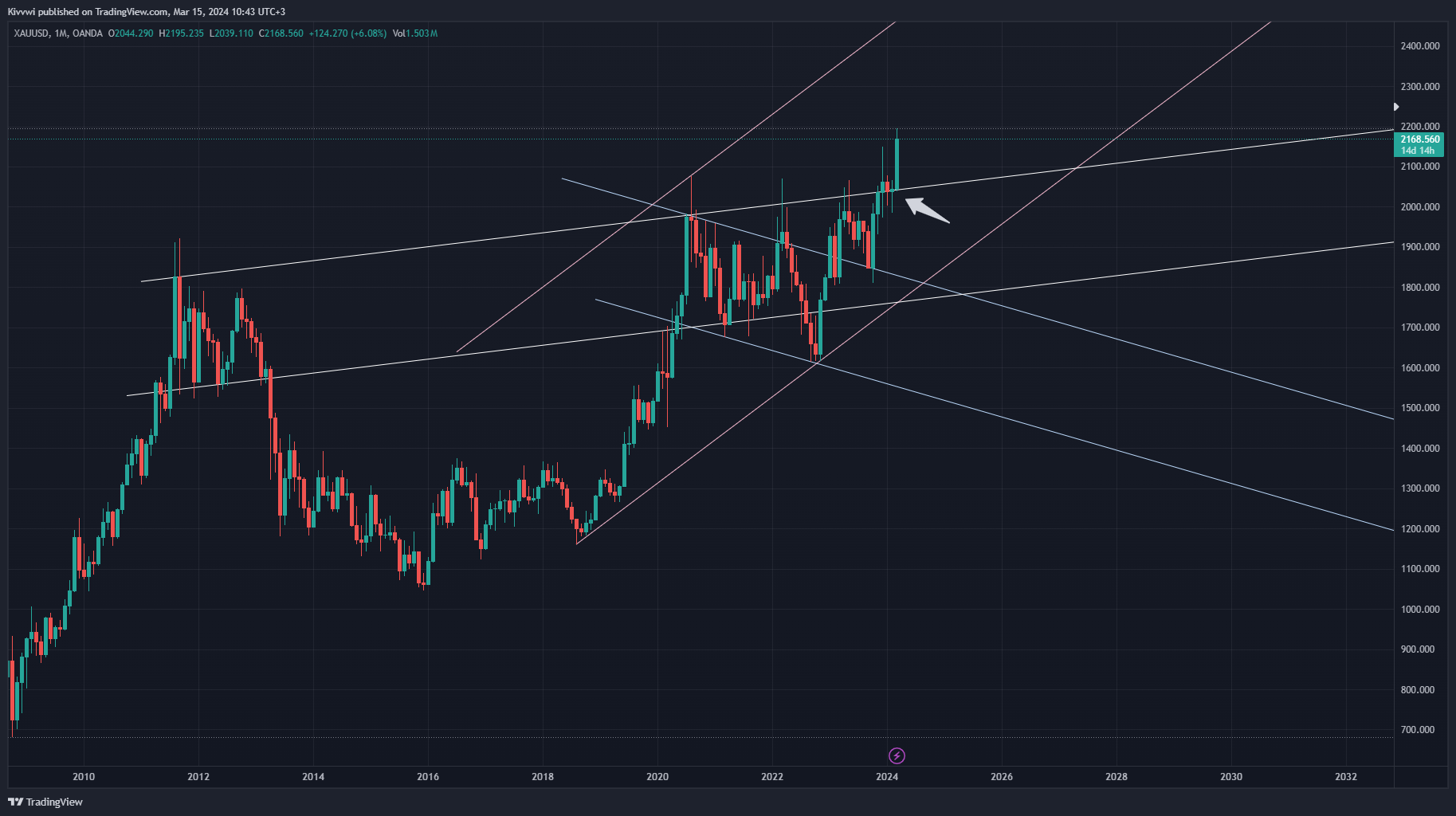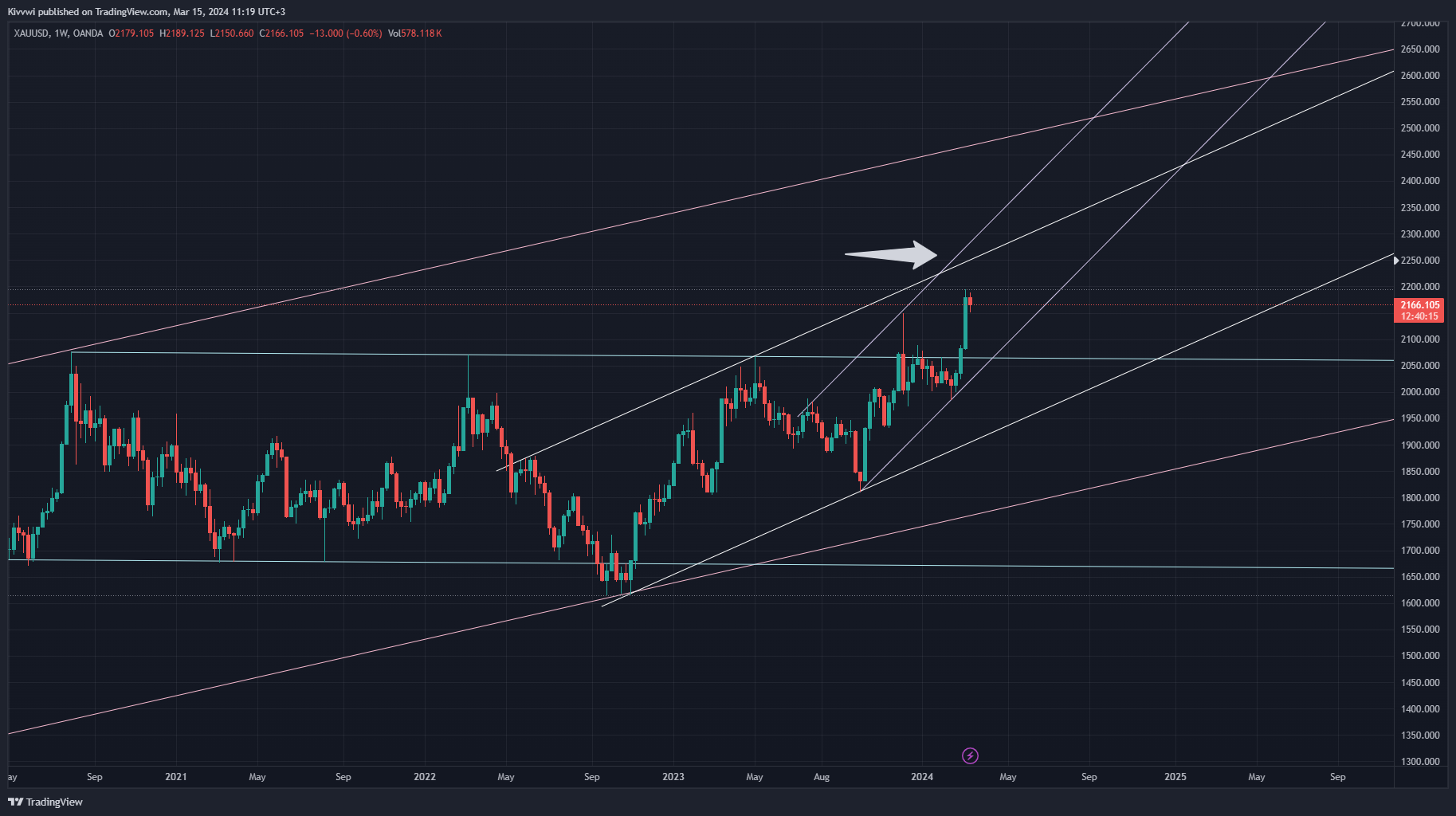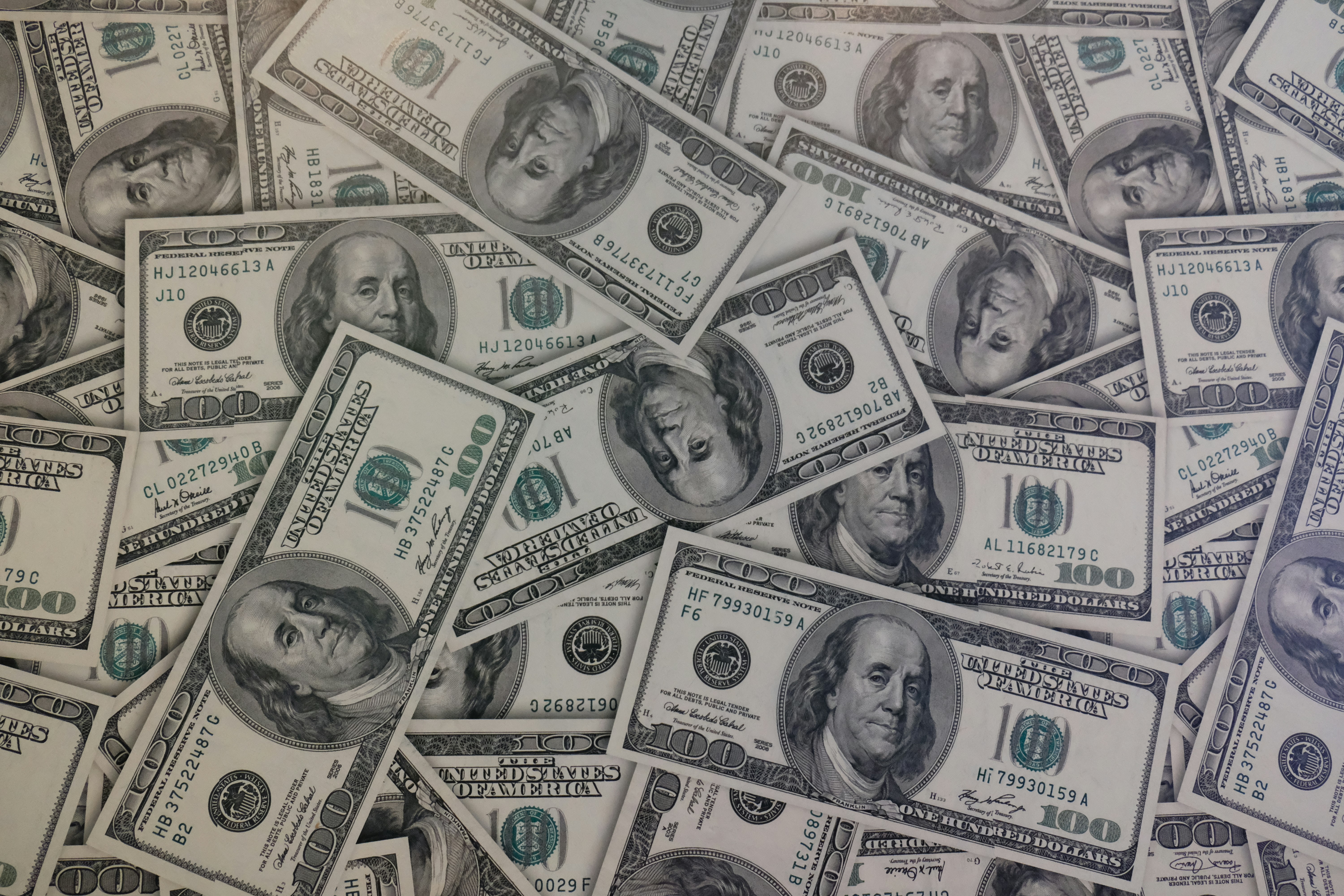Prediksi Harga Emas
Salah satu aset paling berharga dan tempat penyimpanan yang aman. Berabad-abad berlalu, tetapi nilainya terus tumbuh karena kelangkaannya dan kekebalannya terhadap kerusakan. Saat ini, emas masih menjadi salah satu aset yang paling mapan dan tersebar luas untuk investasi, terutama dalam jangka panjang. Apakah Anda mempertimbangkan untuk menambahkannya ke portofolio Anda? Baca panduan utama ini untuk prediksi harga emas 24 karat per ons: berapa harganya besok, tahun 2024, 2025, dan seterusnya.Digunakan sebagai alat tukar dan perdagangan sejak zaman dahulu, emas telah dipandang seb/agai
Daftar Isi
Analisis Teknis Emas
Grafik Riwayat Harga Emas
Prediksi Harga Emas 2025
Prediksi Harga Emas 2026
Prakiraan Harga Emas 2030
Prakiraan Harga Emas untuk 5 Tahun Mendatang
Prediksi Harga Emas untuk 10 Tahun Mendatang
Prediksi Nilai Tukar Emas untuk 20 Tahun Mendatang
Apa yang Memengaruhi Harga Emas?
Inflasi
Fluktuasi Mata Uang
Masa Geopolitik yang Tidak Menentu
Suku Bunga
Kendala Pasokan
Apakah Emas Merupakan Investasi yang Baik?
FAQ
Analisis Teknis Emas
)
Jika mempertimbangkan semua hal, lonjakan harga emas dalam beberapa tahun terakhir benar-benar meningkat pesat dalam beberapa hari pertama bulan Mei, naik 26,3% dalam 7 bulan menjadi $2.050. Itu tidak jauh dari harga penutupan tertinggi, yang mencapai rekor tertinggi pada awal Agustus 2020 di $2.062. Komite Pasar Terbuka Federal (FOMC) dari Federal Reserve terakhir kali menaikkan suku bunga dana federal sebesar 25 basis poin, yang diikuti oleh kenaikan harga emas terbaru. Ini menunjukkan kisaran tipikal 5,13%.
Karena leverage yang ekstrem yang terlibat dalam pasar ini, spekulan biasanya mengendalikan arah harga emas dalam jangka pendek. Gaji AS turun 1,6% pada hari Jumat, 5 Mei sebagai akibat dari penurunan musiman harga emas untuk bulan tersebut. Kejutan positif signifikan lainnya dalam data pekerjaan bulanan AS untuk bulan April sebagian besar bertanggung jawab atas hal ini.

Dalam tren merah muda, kecenderungan naik yang kuat sedang muncul. Jika tidak turun di bawah level ini, emas akan mampu melampaui $2.200. Kemungkinan besar, aset akan mengikuti tren, dan bahkan mencapai level $2.400, kecuali jika ada penurunan yang jauh lebih kuat daripada yang biru.
Sekarang setelah perilaku jangka panjang telah diverifikasi, mari kita lihat perilaku jangka pendek – lihat grafik 1W. Penurunan ke $1.850 tidak hanya akan mematikan tren naik jangka panjang, tetapi juga akan memperpanjang periode pemulihan

Bingkai ini juga menunjukkan perubahan arah bullish yang dapat dikenali. Dalam kenaikan warna merah muda yang dijelaskan sebelumnya, terdapat penurunan warna biru yang terputus-putus. Tren kenaikan yang lebih curam (ungu) seharusnya dapat mendorong harga melewati tren putih dan naik ke angka $2.250 jika terus naik di atas ambang batas $2.200.
Harga kemungkinan akan tetap berada di atas kisaran atas tren putih di sekitar $2.250. Setelah periode stabilisasi singkat, tren putih mungkin akan terbentuk dalam versi yang jauh lebih tinggi, sehingga tren sebelumnya menjadi lama, dan meningkat dengan cepat di atas $2.400. Level $2.080 kemungkinan besar akan diuji ulang, dan mungkin bahkan jauh lebih rendah jika harga mulai turun di bawah $2.200.
Grafik Riwayat Harga Emas
)
Harga emas telah berfluktuasi selama seabad terakhir, dengan beberapa point penting yang perlu diperhatikan. Berikut ini adalah sejarah singkat harga emas selama seratus tahun terakhir:
Pada tahun 1920, harga emas adalah $20,67 USD per ons. Nilai rata-rata ini tetap stabil hingga tahun 1930-an, ketika Franklin D. Roosevelt mendevaluasi USD dan menaikkan biaya logam mulia tersebut menjadi $35.
Selama Perang Dunia II, pemerintah AS menetapkan harga emas pada $35 untuk membiayai anggaran perangnya. Nilai ini bertahan hingga tahun 1970-an dan tetap berada di sekitar level yang sama. Namun, inflasi yang meningkat dan ketidakpastian ekonomi menyebabkan lonjakan permintaan emas sebagai salah satu pilihan investasi yang paling aman.
Pada tahun 1971, Presiden Nixon mengakhiri standar emas, yang jelas-jelas menaikkan harga. Pada tahun 1980, aset tersebut mencapai titik tertinggi sepanjang masa sebesar $850 karena ketidakstabilan politik, inflasi, dan berbagai peristiwa geopolitik, seperti invasi Uni Soviet ke Afghanistan. Tahun 1980-an dan 1990-an ditandai oleh stabilitas relatif: harga emas bertahan di kisaran $400 selama bertahun-tahun.
Pada tahun 2008, krisis keuangan global memicu pertumbuhan harga emas: mencapai $1.000 berkat investasi yang membanjiri aset yang aman ini.
Dari tahun 2011 hingga 2015, harga emas menembus batas baru. Harga mencapai titik tertinggi sepanjang masa di $1.900 pada tahun 2011. Namun, nilainya menurun pada tahun 2013, dan pada tahun 2015, turun menjadi sekitar $1.050. Pada tahun 2023, emas melampaui ambang batas $1.900, dan masih bertahan di kisaran tersebut.
Selama beberapa tahun terakhir, biaya emas relatif stabil, dan fluktuasi kecil terjadi karena peristiwa geopolitik dan ketidakpastian ekonomi.
Prediksi Harga Emas 2025
Faktor-faktor penting yang memengaruhi tahun berjalan diperkirakan akan meningkat secara substansial hingga tahun 2025. Kinerja emas sebagai aset berisiko kemungkinan akan meningkat karena kebijakan Fed yang lebih ketat dan perlambatan pertumbuhan ekonomi berikutnya.
Berikut beberapa prediksi dari berbagai sumber:
Menurut Wallet Investor, pada tahun 2025, harga pembukaan emas diperkirakan mencapai $2.179. Pada akhir tahun 2025, harga penutupan akan meningkat menjadi $2.229 dari harga penutupan sebelumnya sebesar $2.210 pada bulan Juni 2025.
Badan Prakiraan Ekonomi mengklaim bahwa biaya emas diperkirakan akan berkisar antara $2.200 hingga $2.500 pada tahun 2025. Perkiraan harga selama lima tahun ke depan adalah $2.600.
Prakiraan Harga Koin untuk tahun 2025 mengatakan harga akan mengakhiri tahun pada level $2.400. Setelah itu, suku bunga akan terus meningkat secara signifikan.
| Tanggal |
Harga Minimum |
Harga Maksimum |
Perubahan |
| July 2025 |
2207.789 |
2231.626 |
1 % ▲ |
| August 2025 |
2232.587 |
2252.943 |
0.9 % ▲ |
| September 2025 |
2230.241 |
2255.152 |
-1.08 %▼ |
| October 2025 |
2229.481 |
2238.001 |
0.25 % ▲ |
| November 2025 |
2233.826 |
2237.307 |
0.06 % ▲ |
| December 2025 |
2229.704 |
2241.447 |
0.23 % ▲ |
Prediksi Harga Emas 2026
Tahun 2026 diperkirakan akan menjadi tahun yang tenang bagi emas dengan pertumbuhan yang stabil namun minor. Berikut proyeksi harga WalletInvestor:
| Tanggal |
Harga Minimum |
Harga Maksimum |
Perubahan |
| January 2026 |
2242.551 |
2269.538 |
1.19 % ▲ |
| February 2026 |
2270.792 |
2287.779 |
0.74 % ▲ |
| March 2026 |
2283.712 |
2290.729 |
-0.26 % ▼ |
| April 2026 |
2284.514 |
2290.763 |
0.06 % ▲ |
| May 2026 |
2279.136 |
2285.092 |
-0.03 % ▼ |
| June 2026 |
2273.365 |
2286.675 |
-0.55 % ▼ |
| July 2026 |
2271.021 |
2294.430 |
0.92 % ▲ |
| August 2026 |
2298.010 |
2317.278 |
0.83 % ▲ |
| September 2026 |
2294.225 |
2318.244 |
-1.01 % ▼ |
| October 2026 |
2292.970 |
2301.070 |
0.28 % ▲ |
| November 2026 |
2297.108 |
2300.560 |
0.04 % ▲ |
| December 2026 |
2293.079 |
2304.081 |
0.21 % ▲ |
Prakiraan Harga Emas 2030
Secara keseluruhan, prediksi harga emas untuk tahun 2030 positif. Akibat ketidakstabilan ekonomi yang berkepanjangan akibat runtuhnya sistem perbankan Eropa dan Amerika, investor mulai kehilangan kepercayaan pada lembaga keuangan tradisional. Jadi, tidak mengherankan jika emas kembali dianggap sebagai investasi yang sangat menguntungkan. Investor memandang emas sebagai penyimpan nilai yang andal selama masa krisis ekonomi.
Tindakan bank sentral juga berkontribusi pada status emas sebagai investasi nomor satu. Untuk mengimbangi dampak ekonomi dari epidemi COVID-19, bank-bank di seluruh dunia menciptakan mata uang dalam jumlah besar. Akibatnya, sektor keuangan mengalami peningkatan likuiditas yang serius, yang memicu kenaikan tingkat inflasi secara global.
Tabel di bawah ini menunjukkan harga emas pada tahun-tahun berikut:
| Tahun |
Nilai Pertengahan Tahun |
Nilai Akhir Tahun |
| 2025 |
$2,589 |
$2,769 |
| 2026 |
$2,801 |
$2,809 |
| 2027 |
$2,894 |
$3,130 |
| 2028 |
$3,345 |
$3,560 |
| 2029 |
$3,703 |
$3,865 |
| 2030 |
$4,133 |
$4,192 |
Prakiraan Harga Emas untuk 5 Tahun Mendatang
Tingkat inflasi, kebijakan bank sentral, dan ketegangan geopolitik merupakan aspek utama yang menentukan prediksi harga emas di masa mendatang yang dibuat oleh para ekonom dan lembaga keuangan.
Pasar saham telah terdampak oleh volatilitas tinggi sejak awal tahun 2022. Harga emas terus meningkat setahun yang lalu, dan kecenderungan kenaikannya belum mereda. Masalah utama yang akan memengaruhi XAU/USD di masa mendatang adalah inflasi. Orang Amerika sedang mengalami masalah inflasi terbesar dalam empat puluh tahun terakhir. Karena emas selalu menjadi alat antiinflasi yang paling efisien, harga mungkin akan naik lebih tinggi lagi dan melampaui $2.000.
Harga emas akan meningkat dalam beberapa tahun mendatang, tetapi mungkin akan kembali melampaui $2.000 dolar per ons. Peristiwa berikut dapat berkontribusi terhadapnya:
Stimulasi fiskal dan moneter yang besar akan memicu meningkatnya ekspektasi inflasi dan depresiasi USD.
Industri logam mulia mungkin akan mengalami masuknya dana dari investor, dan peningkatan permintaan konsumen yang lambat namun stabil di seluruh Tiongkok dan India.
Karena mereka akan berhenti menghasilkan pendapatan, obligasi pemerintah (utang pemerintah) tidak akan berfungsi sebagai aset defensif terhadap inflasi dan suku bunga negatif. Emas akan banyak digunakan sebagai lindung nilai dalam situasi geopolitik yang menegangkan. Dalam kasus ini, biaya peluang untuk memiliki emas akan turun. Berikut adalah prediksi harga emas 5 tahun:
| Tahun |
Nilai Pertengahan Tahun |
Nilai Akhir Tahun |
Tod/End,% |
| 2025 |
$2,526 |
$2,701 |
+25% |
| 2026 |
$2,732 |
$2,740 |
+27% |
| 2027 |
$2,823 |
$3,053 |
+41% |
| 2028 |
$3,263 |
$3,472 |
+61% |
| 2029 |
$2,289 |
$2,312 |
+7% |
Prediksi Harga Emas untuk 10 Tahun Mendatang
Grafik prediksi harga emas untuk sepuluh tahun mendatang tampak positif, karena perkiraan umum emas masih berlaku bahwa nilainya hanya akan meningkat, terutama mengingat krisis keuangan sudah di depan mata, dan kita dapat mengamati apa yang terjadi dalam sepuluh tahun setelah 2008.
Menurut Dohmen Capital Research, krisis global 2008 adalah contoh terkini yang tepat. Ketika kredit menjadi lebih terbatas, krisis meningkat, orang-orang berbondong-bondong untuk menguangkan semua aset, dan emas turun hingga 31%. Bagi investor yang tidak menyadari bahwa krisis keuangan
menyebabkan semua aset jatuh nilainya, itu mengerikan. Namun, pada dasarnya, itu juga menghasilkan peluang pembelian yang fantastis.
Dengan mempertimbangkan semua poin ini, emas masih tetap menjadi investasi yang layak karena nilainya kemungkinan akan berlipat ganda dalam perspektif 10 tahun, tetapi, tentu saja, itu akan bergantung pada sejumlah faktor politik dan ekonomi.
Tabel di bawah ini menampilkan perkiraan harga emas 10 tahun dengan harga minimum dan maksimum:
| Tahun |
Nilai Pertengahan Tahun |
Nilai Akhir Tahun |
Tod/End,% |
| 2025 |
$2,526 |
$2,701 |
+25% |
| 2026 |
$2,732 |
$2,740 |
+27% |
| 2027 |
$2,823 |
$3,053 |
+41% |
| 2028 |
$3,263 |
$3,472 |
+61% |
| 2029 |
$3,611 |
$3,769 |
+75% |
| 2030 |
$4,030 |
$4,087 |
+89% |
| 2031 |
$4,124 |
$4,249 |
+97% |
| 2032 |
$4,465 |
$4,688 |
+117% |
| 2033 |
$4,910 |
$5,103 |
+136% |
| 2034 |
$5,322 |
$5,540 |
+157% |
| 2035 |
$5,757 |
$5,973 |
+177% |
Prediksi Nilai Tukar Emas untuk 20 Tahun Mendatang
Memprediksi harga emas pada tahun 2040 sangatlah spekulatif dan tidak pasti. Banyak faktor yang memengaruhi harga emas dalam semua jangka waktu, dan interaksi faktor-faktor tersebut membuat prakiraan jangka panjang menjadi tidak dapat diandalkan.
Perkiraan untuk 20 tahun mendatang akan bergantung pada kondisi ekonomi global: inflasi, suku bunga, fluktuasi mata uang, dan puluhan faktor lainnya. Ketika dunia khawatir tentang inflasi atau ketidakstabilan ekonomi, investor mungkin mencari perlindungan dalam bentuk emas, yang kemudian harganya akan naik.
Ketegangan geopolitik, sengketa perdagangan, ketidakstabilan politik, dan peristiwa global yang besar dapat memengaruhi sentimen investor dan meningkatkan permintaan emas sebagai aset safe haven. Bank sentral memiliki cadangan emas yang signifikan, dan aktivitas pembelian atau penjualan mereka dapat memengaruhi pasar. Perubahan kebijakan mereka, seperti peningkatan pembelian emas, dapat mendongkrak harga.
Penawaran dan permintaan emas merupakan penentu penting harganya. Faktor-faktor seperti tingkat produksi emas, kemajuan teknologi dalam pertambangan, permintaan perhiasan, dan penggunaan industri dapat memengaruhi keseimbangan antara penawaran dan permintaan.
Sentimen investor, spekulasi pasar, dan aktivitas perdagangan emas berjangka dan instrumen keuangan lainnya juga dapat berdampak jangka pendek pada harga emas. Faktor-faktor ini dapat dipengaruhi oleh berbagai keanehan psikologis dan perilaku yang sulit dianalisis.
Apa yang Memengaruhi Harga Emas?
Karena emas merupakan salah satu aset tertua, nilainya bergantung pada sejumlah besar faktor, yang akan kita bahas di bawah ini.
Inflasi
Inflasi merupakan salah satu faktor utama yang memengaruhi harga emas – keduanya memiliki korelasi negatif. Ketika naik, mata uang asli mulai kehilangan nilainya, yang menyebabkan investor mencari aset yang tahan krisis seperti emas. Meningkatnya permintaan emas mendorong kenaikan harganya.
Sebaliknya, ketika inflasi rendah, nilai mata uang stabil, yang mengurangi daya tarik emas sebagai investasi dan menyebabkan harganya turun.
Fluktuasi Mata Uang
Fluktuasi mata uang dapat berdampak signifikan pada harga emas. Ketika mata uang melemah, hal itu sering kali mendorong kenaikan harga emas, karena logam mulia ini dianggap sebagai aset yang aman, dan investor cenderung beralih ke sana selama masa ketidakpastian ekonomi.
Selain itu, dolar yang melemah membuat emas relatif lebih murah bagi pembeli asing, sehingga meningkatkan permintaannya. Ketika mata uang menguat, hal itu dapat menyebabkan penurunan harga emas karena menjadi relatif lebih mahal bagi pembeli asing.
Masa Geopolitik yang Tidak Menentu
Emas sering kali lebih disukai daripada aset lain untuk investasi selama periode ketidakstabilan geopolitik. Ketika terjadi ketegangan atau konflik antarnegara, investor mencari stabilitas dan keamanan emas, yang meningkatkan permintaan dan harganya. Peristiwa geopolitik seperti kerusuhan politik, sengketa perdagangan, atau perang dapat menciptakan ketidakpastian yang tinggi di pasar keuangan, yang menyebabkan investor kecil dan besar berbondong-bondong mencari emas sebagai lindung nilai terhadap potensi risiko ekonomi. Itu berarti harga emas cenderung naik selama masa gejolak geopolitik.
Suku Bunga
Ketika suku bunga rendah, peluang untuk memegang aset yang tidak menghasilkan seperti emas berkurang. Hal ini membuat emas menjadi investasi yang lebih berharga dan lebih aman, yang
menyebabkan peningkatan permintaan dan harga yang lebih tinggi. Ketika suku bunga naik, investor dapat beralih ke aset yang menghasilkan hasil, mengurangi permintaan dan berpotensi menurunkan harga emas.
Kendala Pasokan
Pasokan terbatas karena kondisi seperti penurunan hasil pertambangan atau gangguan dalam rantai pasokan dapat memicu permintaan yang lebih tinggi dan selanjutnya harga naik. Ketika pasokan emas terbatas, emas menjadi lebih berharga karena kelangkaan. Investor dapat mengantisipasi kekurangan di masa mendatang dan meningkatkan permintaan, yang menyebabkan harga naik. Sebaliknya, jika volume emas meningkat, hal itu dapat menyebabkan kelebihan pasokan dan berpotensi menurunkan harga karena pasar emas menjadi lebih jenuh.
Apakah Emas Merupakan Investasi yang Baik?
Dalam jangka pendek, emas dapat dilihat sebagai pilihan investasi yang menguntungkan bagi investor perorangan yang ingin melindungi diri dari risiko pasar dan menjaga modal. Emas dianggap sebagai aset yang aman dan berharga selama masa ketidakpastian ekonomi atau volatilitas pasar.
Dalam jangka menengah, biaya emas dapat dipengaruhi oleh faktor-faktor seperti inflasi yang tinggi, kebijakan bank sentral, dan kondisi pasar secara keseluruhan. Tindakan bank, seperti kenaikan atau penurunan suku bunga dan stimulus moneter memengaruhi semua aset yang diperdagangkan. Emas dapat menjadi bagian dari portofolio untuk pelestarian dan diversifikasi kekayaan jangka menengah.
Dalam jangka panjang, kinerja emas pasti akan bergantung pada tren ekonomi global, fluktuasi mata uang, dan dinamika penawaran/permintaan. Manfaat utama emas adalah nilainya yang tidak berubah selama berabad-abad, dan pasti akan terus dianggap sebagai penyimpan kekayaan.
Secara keseluruhan, prediksi untuk tahun 2027 dan tahun-tahun berikutnya positif. Seiring pertumbuhan ekonomi dan peningkatan populasi, permintaan emas, khususnya di pasar global yang sedang berkembang, mungkin meningkat. Lebih jauh lagi, persediaan emas terbatas, dan penambangan cadangan baru menjadi lebih menantang, yang berpotensi mengarah pada prospek positif jangka panjang untuk harga emas. Logam mulia dapat dilihat sebagai investasi yang aman yang memungkinkan pemegangnya untuk melindungi diri dari devaluasi mata uang dan mencapai diversifikasi portofolio yang optimal.
FAQ
Berapa harga emas pada tahun 2030?
Pada tahun 2030, harga emas diperkirakan akan meningkat lebih dari 40%, dari $3.186 menjadi $4.515. Emas akan memulai tahun 2030 pada harga $3.186, naik menjadi $3.377 pada paruh pertama tahun ini, dan mengakhiri tahun pada harga $3.418. Tepatnya, itu sekitar +76% dari harga saat ini. Namun, beberapa perkiraan tidak terlalu optimis, yang menunjukkan bahwa kenaikan harga emas selanjutnya tidak akan melampaui ambang batas $3.000 saat ini.
Berapa prediksi harga emas untuk tahun 2040?
Tidak banyak perkiraan yang dapat diandalkan, tetapi selisih antara prediksi sangat besar – dari $2.989,02 menjadi $53.525,53. Karena ini lebih dari 15 tahun ke depan, biayanya masih akan bergantung pada banyak faktor, seperti situasi geopolitik, kekuatan USD, dan mata uang kripto.
Bagaimana prediksi harga emas untuk tahun 2050?
Pada tahun 2050, kita mungkin akan melihat harga XAU/USD pada level $10.000 dan lebih tinggi, terutama jika ekonomi AS mengalami keruntuhan besar-besaran. Namun, ini adalah skenario yang sangat optimis untuk aset tersebut, karena ada banyak kondisi global lain yang memengaruhi biayanya dalam jangka panjang.
Bagaimana prediksi harga emas untuk tahun 2025?
Menurut perkiraan XAU/USD tahun 2025, biaya aset tersebut diperkirakan akan tetap berada dalam kisaran $2.170 - $2.250. Perkiraan yang paling optimis mengklaim bahwa nilainya akan naik menjadi $3.500. Namun, semuanya tergantung pada bagaimana tren pasar keuangan akan berkembang.
Apakah emas akan kehilangan nilainya?
Ya, bahkan emas tidak kekal terhadap perubahan ekonomi. Emas mungkin akan kehilangan nilainya di masa mendatang karena perubahan ekonomi global, posisi USD, pergeseran dinamika penawaran dan permintaan, serta kemajuan teknologi. Namun, emas telah menjadi aset berharga selama berabad-abad, dan dianggap sebagai pilihan yang lebih aman daripada banyak aset lainnya.

)
